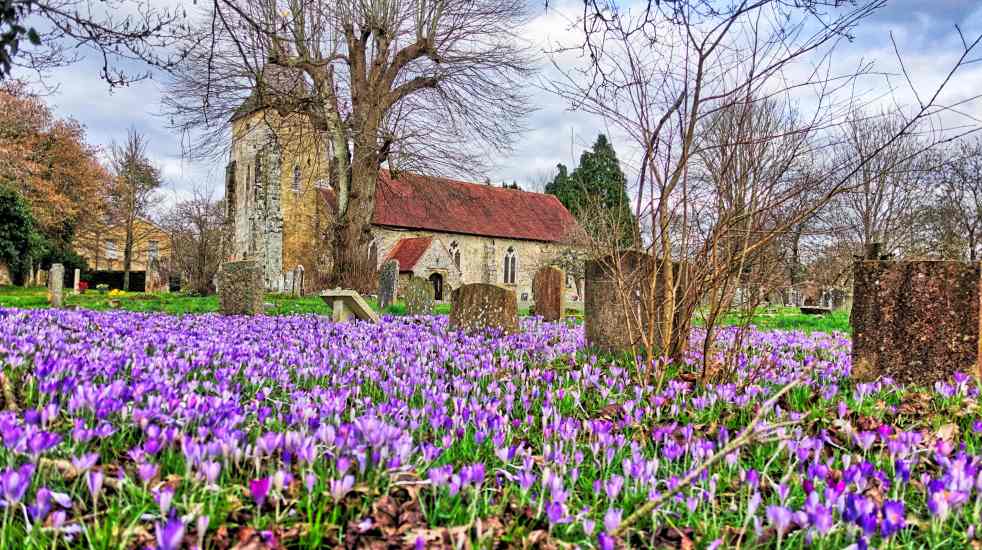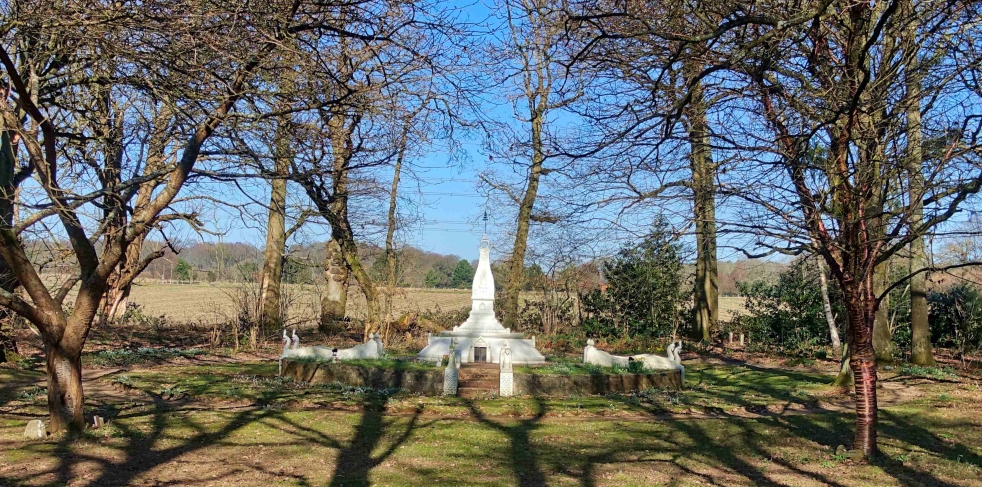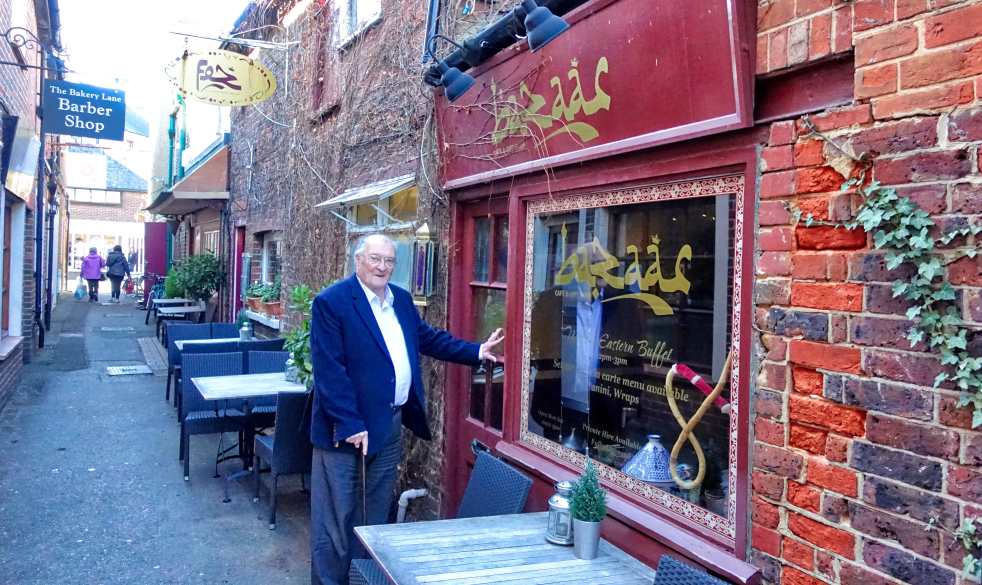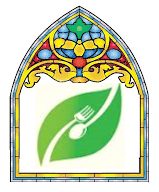Although the trees were still bare there was a definite spring-like feeling to the day as we travelled along the country lanes to the small village of Trotton. Strictly speaking the Church of St George shouldn’t qualify for a visit as it is not in Hampshire, but we were enticed by the prospect of seeing some of the finest medieval wall paintings in the area and anyway, Trotton was only 6 miles over the border into Sussex. An added attraction was the fact that we would see two churches for the price of one, as St Marys Church, only a mile away in the hamlet of Chithurst, is linked within the same benefice as St George.
As we arrived in Trotton we crossed the River Rother on a rather interesting and beautiful stone bridge. It was built in the year 1400 by Lord Camoys who held the Manor of Trotton at the time. It seems to me quite astonishing that a bridge constructed 600 years ago, designed to carry no more than horse drawn hay carts and the occasional column of marching troops, now has to support the weight of the procession of buses, lorries and cars that now blight our country roads.
Apart from the bridge and the church there is not much to see in Trotton although we did find a garden centre cafe where we enjoyed a couple of freshly brewed coffees before continuing onto our main destination, The Church of St George.


Built in the first half of the 14th century, the Church of St George has changed little over the years. As with so many other churches we have visited, it replaced an earlier place of worship about which little is known other than it was recorded in the great Domesday book of 1089.

The church is best known for its association with the Camoys family. Lord Camoys has already been mentioned as the person responsible for building the adjacent four arch bridge, but he also sponsored the building of the church itself. However, his real fame is for his heroic service to Henry V as commander of the left flank of the English army at the Battle of Agincourt in 1415.
The table tomb containing the remains of Lord Camoys and his wife Elizabeth is prominently placed in the chancel between the choir stalls. Incidentally, Elizabeth was the ‘Gentle’ Kate mentioned by Shakespeare in his play Henry IV. Surmounting the tomb is a magnificent memorial brass which is unusual in that instead of portraying the couple in a typically pious pose with their hands in an attitude of prayer, the engraver shows them holding hands, a touching gesture. The tiny figure in the bottom left hand corner represents a son who died in infancy
The two superb London-made memorial brasses are almost life size and have been described as the biggest and best preserved in England. We had to roll back a protective rug in order to see the quite remarkable brass shown on the right. It dates from 1310 and is one of very few that commemorates a woman alone. Her name was Margaret Camoys, but due to the frequency of this name in the family, her identity in uncertain. The 9 recesses in her tunic would, at one time, have contained enamelled coats of arms and their unfortunate loss removes all evidence of her identity.

The 14th century wall paintings immediately catch the eye on entering the church. Obliterated by whitewash at the time of the reformation they were re-discovered in 1904, although the first attempts at proper conservation were not carried out until the 1950’s. It would then take another thirty years before a full conservation was completed by the Courtauld Institute of Art. Although paintings can be seen on the north and south walls, the most dramatic images are on the west wall, particularly on the right hand side which is more protected from sunlight.
Above the doorway, Christ can be seen sitting in judgement on a rainbow. On either side of him is an angel. At Christ’s left hand, the angel welcomes the naked figures of the blessed into paradise. The other angel delivers sinners to eternal torment. Then, lower down, are two groups of seven images presumably intended to help guide the congregation into leading better lives. On the left, unfortunately rather faded, the seven deadly sins are displayed, pride, lust, anger, envy, gluttony, sloth and avarice. In the centre, a sinner is depicted being tortured by demons. An erect phallus was removed from the image of lust when the paintings were found in 1904. What was acceptable in the 14th century was definitely not in the 20th!

On the right hand side, the Seven Acts of Corporal Mercy can be seen surrounding the image of a ‘Good Man’. They depict ‘Clothing the Naked’, ‘Feeding the Hungry’, Tending the Sick’, Visiting the Prisoner, Giving Drink to the Traveller, Welcoming the Stranger and Burying the Dead.

I was rather touched by the variety of colourful kneelers resting on the pews. They feature a wide variety of local subjects ranging from the transportation of a Trotton man to Australia in 1847 for stealing a ewe, to the closure of the village post office in 1976. Presumably they were embroidered by the various members of the congregation.
Chithurst
Before flowing through Trotton, the river Rother passes through the wooded village of Chithurst. Although it is only a small community of around 100 residents, there are three intriguing properties along the river bank that I felt deserved investigation. In the event we were able to visit just two, a Norman Church and a Buddhist Monastery. Between these two buildings sits a rather grand Victorian Manor House that, for many years, was known as the Chithurst Healing Centre. It was set up and run by the Hollywood icon Sarah Miles, fondly remembered by many of my generation for her role in Ryans Daughter. Sadly though, it seems that the centre has now closed.
St Mary Church, Chithurst

The church, although exceedingly small is big on history. It was originally built in the late 11th century on a man-made mound that is thought to have been used as a prehistoric burial barrow and a place of heathen worship in pre-Christian times. During the medieval period Chithurst was not a prosperous place and in 1291 it was granted an exemption from taxes by Pope Nicholas due to the extreme poverty of the parish. Chithurst must have been a sleepy place throughout most of its life, but that ended in 1757 when the rector, Rev John Denham, was stabbed and murdered. The culprit, a man by the name of Aps was later tried and convicted at Horsham. He was hanged, with a contemporary report stating that he ended “his wicked life without the least sign of repentance”. A candidate for eternal torment if ever there was!

The interior could hardly be more simple. There is no electrical connection or provision for heating. Candle holders are still in place and the most modern contents are the 17th century box pews. Nevertheless it had an appealing atmosphere of utter tranquility.
Cittaviveka

When I first mentioned the idea of visiting the Amaravati Buddhist Monastery I sensed a distinct lack of enthusiasm from BQ, he didn’t think there would be sufficient time, there wouldn’t be anything much to see when we got there and finally he used the excuse of hunger as a reason why we should move on to Petersfield for lunch. I dismissed these objections and assured him that we would be welcome. I had seen the website which invited all-comers not only to visit, but to join the monks in meditation and chanting. There was also an invitation to share a meal with the residents or even take advantage of staying in simple accommodation in the beautiful park-land setting. It couldn’t have been more welcoming. However BQ was not convinced and as we made our way down the drive past a strangely mystical sculpture, his lack of enthusiasm changed to distinct apprehension. But he should not have worried for, on arrival, we discovered we had come during the annual 10 week period of silence and contemplation and the place was deserted. But, nonetheless we looked around the extensive and rather beautiful site, or rather I did, while BQ sat under the watchful gaze of an inscrutable Buddha in the Dhamma Meditation Hall.


The Fez Restaurant, Petersfield

Although it was a mid-week lunchtime, when we arrived at the Fez Restaurant in the centre of Petersfield, we were surprised to find it empty. That is normally not a good sign, but the food was good, promptly prepared, reasonably priced and served by two charming Turkish waitresses in this family business. What more could one ask?

BQ’s Impressions
The Spear Carrier
Amateur theatre and opera allows opportunities for many diverse characters who have minor parts but who generally appear in the background. Thomas Lord Camoys, who is commemorated by a magnificent brass memorial in this church, is such a character. For he would surely have been present in the background in scenes featuring the court in Shakespeare‘s Henry IV parts one and two and Henry V. It is interesting to speculate if I ever played him during my time performing on the amateur stage, as I never managed to achieve a major part in these histories; not dissimilar to my role in Dine and Divine where I am relegated to minor parts, either freezing my action, waiting for the click of MW’s camera or hiding whilst the drone circles above.
Lord Camoys however was completely upstaged by his wife who was none other than ‘Gentle Kate’ who has one of the best female roles in the Shakespeare histories, berating her first husband, Sir Harry Hotspur, for not coming to her bed. As a high born member of the Mortimer family she threatens to break his phallus with the excuse that such action would make him ‘too soft’ for the battle that lay ahead – a scene reflecting the ambiguity of sexual orientation, so often found in Shakespeare. One imagines that before she was interred in the magnificent tomb alongside her much decorated and admired husband, she could have had no inkling that her place in history would be as a major player, whilst his role was destined to be that of a mere ‘spear carrier’ thanks to Mr Shakespeare..
The grade one Church of St George is a plain barn of a structure from outside but its interior is a box of diamonds, not only for the brasses and memorials, but also for the astonishing array of medieval wall paintings in various stages of preservation. Looking closely at the walls I would imagine that the entire church would originally have been decorated. On entering the building I was immediately struck by the dramatic images on the west wall depicting the Last Judgement and the contrasting results of living a life of virtue or sin. Even in these sophisticated times when congregations are literate, these naive wall paintings have more meaning than any written strictures.
After such a rich mixture, the visit to the humble Norman Church at Chithurst could be compared to an alka-seltzer after too good a night out. Without all the excesses of the previous visit I found the power of prayer in this modest building came easily.
Set on a mound above the river Rother, the seat outside was heavenly as the only noise was of moving water and birdsong, but yet again my reverie was interrupted by MW whose passion for constant discovery can be a little wearing. Was this at last lunch? No, he had discovered a Buddhist retreat and monastery further up the road and, whilst in the area, a visit was paramount. So I found myself, unbelievably, seated before the Buddha in silence apart from MW’s military style shiny shoes as he clip-clopped around on the marble floors. All this in what we discovered was during monks silent period!
Thence, a return to Hampshire and Petersfield for lunch at the Fez brasserie, a hidden small gem discovered by MW in the lanes that surround the main square. During the years of living mid-week in the West End of London, I became a lover of Turkish cuisine and this restaurant lived up to my expectation. The surprise was reserved for the wine, which was full bodied and delicious and was also Turkish. So ended a full, but intensely satisfying trip across the border in the most glorious weather.
- Our lunch
- Imam Bayildi; Aubergine stuffed with peppers, onion and tomato and baked in the oven. BQ
- Falafel; Deep fried balls made from ground chickpeas, fava beans and coriander seeds, served with Turkish salad, hummus and yoghurt. MW
- Fez Kofte; Minced lamb with rice and salad. BQ
- Imam Bayildi; Aubergine stuffed with peppers, onion and tomato and baked in the oven. MW
- Villa Doluca Red Klassic; A dry red wine from Turkey. BQ and MW



I get as much enjoyment reading your posts the second and third times as I do the first read!! The photos of the medieval wall paintings are great. Some paintings can say it all, can’t it. BQs role in D&D gave rise to a chuckle.
Keep them coming……….thanks Chris
LikeLike